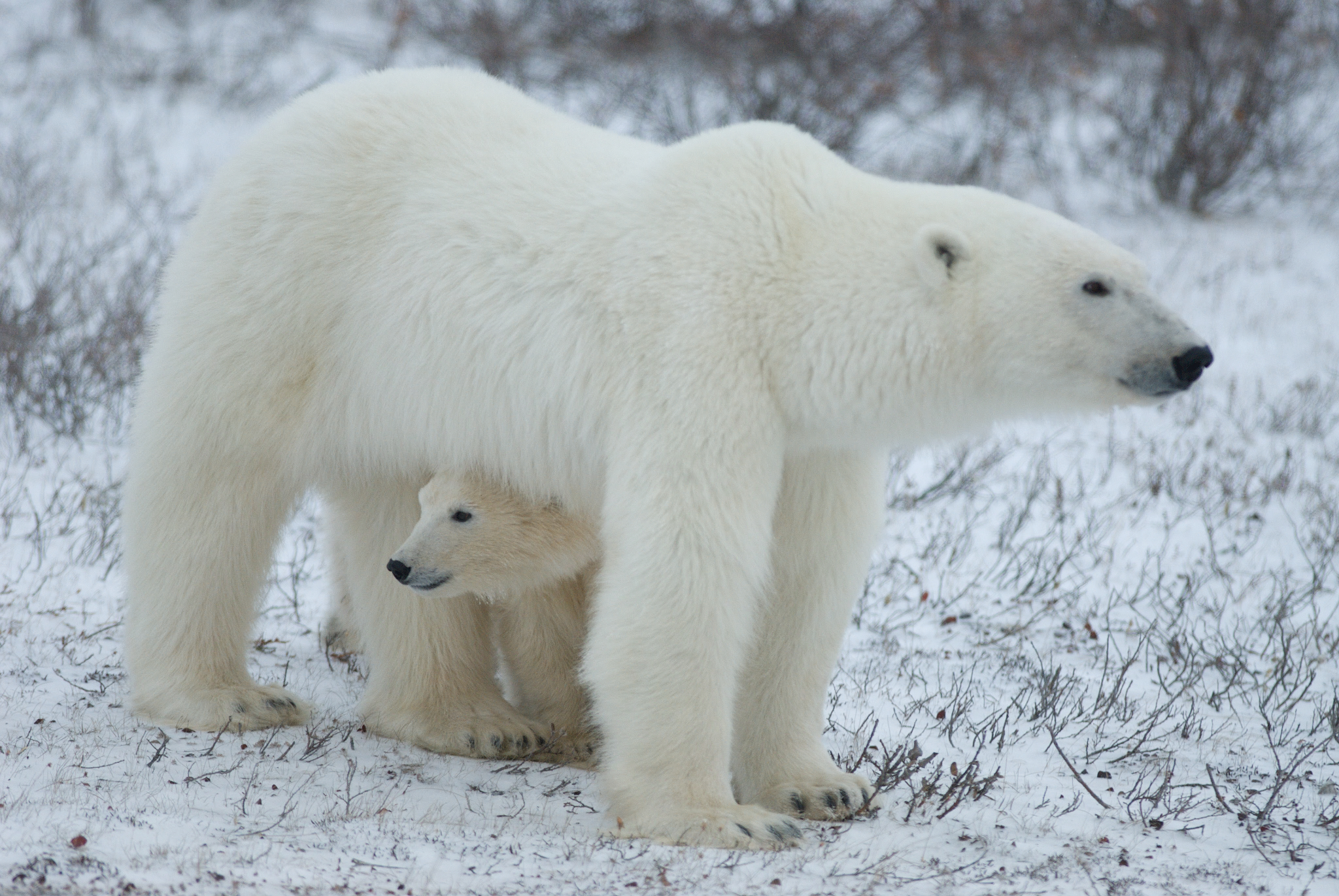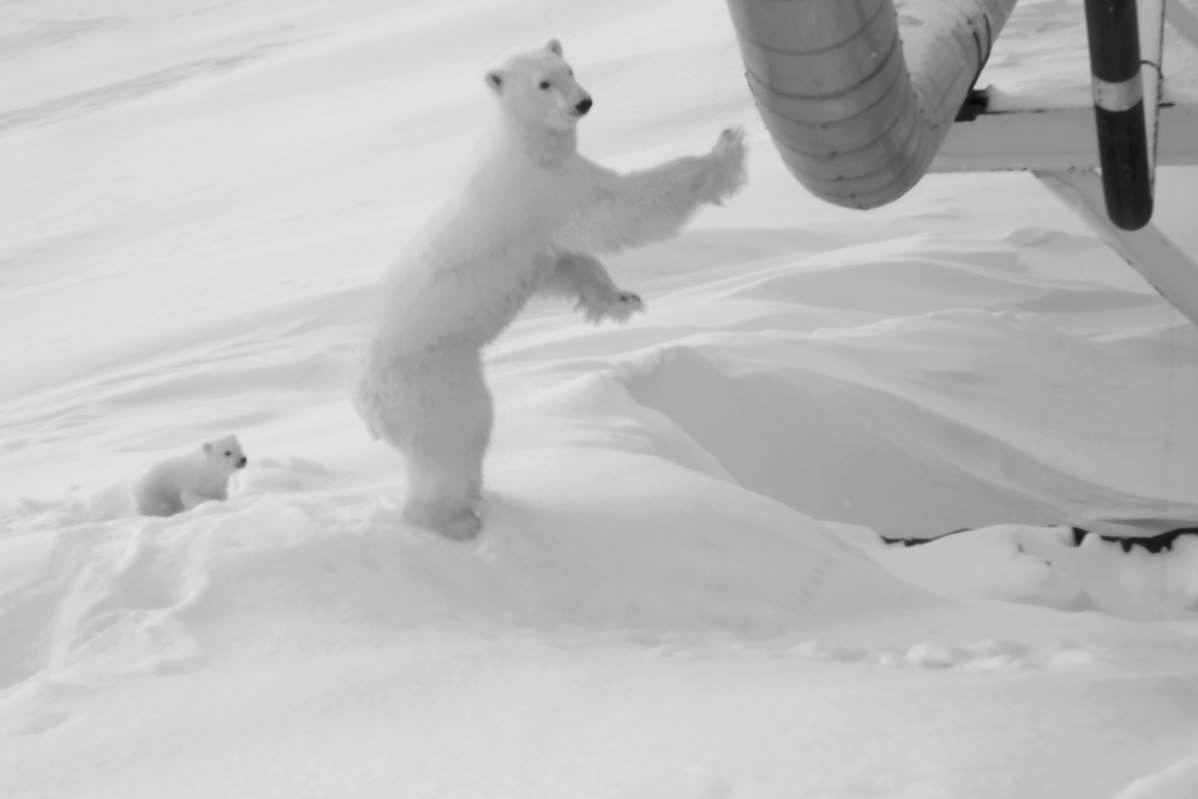Denning polar bears need better protection from Alaska oil development, scientists say
The industry's current method for detecting dens missed more than half of the dens biologists found during a recent study.

For the oil industry, safe operations on Alaska’s North Slope require avoidance of polar bears. But for more than a decade, a new study has found, the industry has done a poor job of detecting polar bear dens, the sites where mother bears dig into the snow to give birth to and nurse their cubs.
In the study, published in the journal PLOS ONE, polar bear biologists found that the industry’s use of aerial thermal imaging to find dens along a stretch of Beaufort Sea coastline failed more than half of the time for a period extending more than a decade.
The scientists compared their own “ground-truth data” about polar bear den during the same period to the 2004-2016 records created by the industry from its use of forward-looking infrared imagery, or FLIR, to detect the animals’ body heat from above.
In the study site, a 224-kilometer (139-mile) stretch of coastline that includes the Prudhoe Bay oil field, the industry’s FLIR detections correctly identified only 45 percent of the 33 dens that the biologists knew that bears were using in the area.
“This isn’t that great. You can do better,” said Tom Smith of Brigham Young University, the lead author.
Among the problems is wind, Smith said. If winds reached speeds of 6 miles an hour or greater, he said, polar bears’ body heat is scattered and cannot be detected, he said. “Even if you wait for the wind to stop, nobody knows how long it takes for the signal to re-emerge,” he said.
The industry’s FLIR readings were sometimes taken during windy periods, the study found.
And if the bears dig their dens deep enough into the snowdrifts, their body heat cannot penetrate to the snow surface to be detected, Smith said.

The results highlight risks to polar bears, which are listed as threatened under the Endangered Species Act, from potential oil development in the Arctic National Wildlife Refuge.
Arctic sea ice retreat has sent more polar bears to land, including maternal bears preparing to give birth to cubs.
Three decades ago, about a third of maternal polar bears in the Southern Beaufort Sea population, the group closest to North Slope oil development, denned on land, according to studies by the U.S. Geological Survey and other agencies. By the 2007-2013 period, the proportion of maternal polar bears denning on land had risen to 55 percent — and the ANWR coastal plain is a prime site for denning, with 3,020 linear kilometers (1,872 miles) of suitable denning habitat, according to the USGS.
Risks to polar bears are among the concerns that have blocked approval for a 3-D seismic survey that companies want to conduct in the coastal plain. SAExploration and two Alaska Native corporations applied in 2018 to the Bureau of Land Management in 2018 for authorization to conduct what would be the first such survey ever conducted in the wildlife refuge’s coastal plain, but the group has yet to get a permit for operating around polar bears.
The loud noises and vibrations from the seismic vehicles could startle and scare bears, causing mothers to abandon their cubs, scientists have warned. It is also possible that denning polar bears could be crushed to death by the heavy vehicles, they have warned.
No recent action has been taken on the seismic permit application that was submitted in 2018, said Lesli Ellis-Wouters, a spokeswoman for the Bureau of Land Management’s Alaska office.
“It’s still on hold. At this point, we will need an updated application for the permit to move forward, and we haven’t received that,” Ellis-Wouters said.
If seismic surveys do take place in the refuge’s coastal plain, there are extra precautions that can be taken to minimize disturbances to denning polar bears, according to a study by federal biologists that was published in December in the Journal of Wildlife Management.
If companies use FLIR imagery properly in combination with several other protections, including time restrictions on operations and detailed habitat analysis to identify likely denning locations in the coastal plain’s varied terrain, they could reduce disturbances to polar bears by more than 90 percent compared to surveys with no restrictions, the study concluded. Modeling showed that “with sufficient planning and effective mitigation measures, the effects to denning bears could likely be reduced sufficiently to allow seismic operators to complete their work over large areas,” said the study, by U.S. Fish and Wildlife Service biologist Ryan Wilson and USGS biologist George Durner.
The Fish and Wildlife Service published the study in the Federal Register on Feb. 18, kicking off a 60-day period for public comment on it.
That is an unusual step for the service to take, said Smith. The possibility of extra costs to the oil industry might be at play in the decision to solicit public comment, he said.
“It has implications for industry. They want to be sure it’s vetted to the hilt,” he said.
Up to now, the oil industry and others on the North Slope have been fairly successful at keeping polar bears and people separated. The last mauling there occurred in 1993 at a military site, and there has never been a mauling within the oil fields.
But climate change is increasing risks of dangerous encounters on the North Slope and across the Arctic. It is also complicating the task of finding polar bear dens, Smith said.
In addition to bringing more bears to land, the Arctic’s warming climate is creating more problems for accurate FLIR readings, he said. Warming has increased frequency of wind events, he noted, and projections are for high-wind events to increase in the future in Arctic Alaska. Warming also puts more moisture into the air, creating more fog that the FLIR technology cannot penetrate, he said.
Improving bear detection would likely be more expensive than the methods the industry is currently using, Smith said. For example, the FLIR surveys would be better conducted by helicopters, which can fly slowly and hover, than by the fixed-wing aircraft that the companies use, but that would be costlier, he said.
But the extra spending might be worthwhile, he said.
He cited a case where the unexpected emergence of a mother bear with cubs temporarily shut down operations along an ice road that was being used to build ExxonMobil’s Point Thomson project. Ultimately, 17 miles of ice road, at a cost of $1 million a mile, had to be rerouted, he said.
Skimping on den detection might be more expensive “if you have a bear pop out someplace that’s unexpected and stops all kinds of work,” he said. “It’s kind of penny-wise and dollar-foolish.”